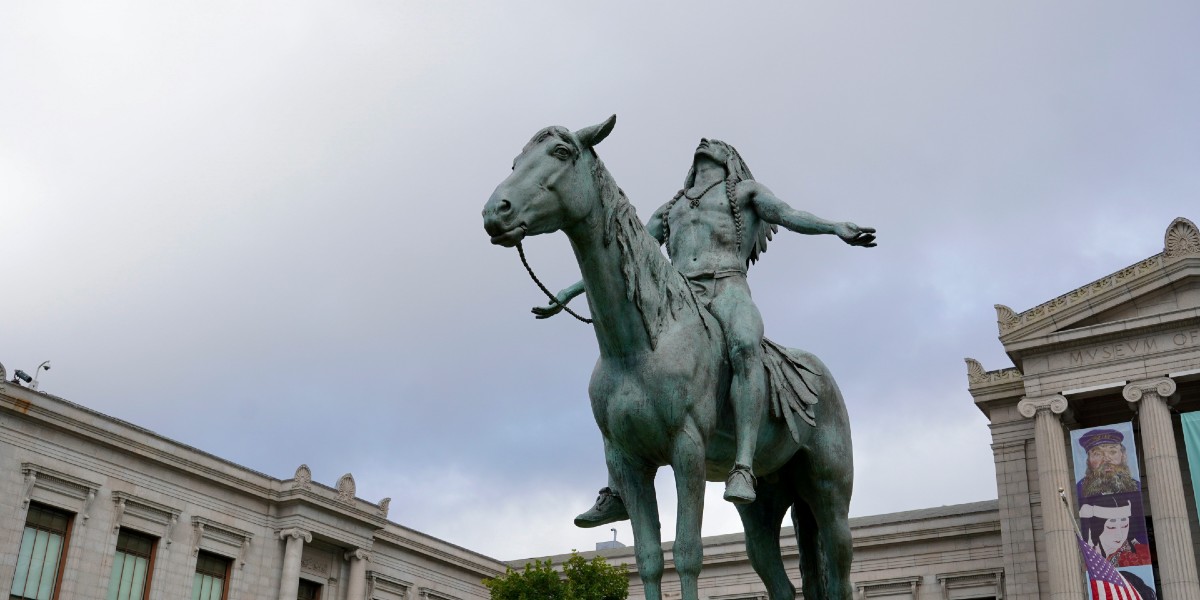Rebecca Nagle is an investigative journalist and a citizen of the Cherokee Nation. She is the writer and host of the podcast This Land. Her writing on Native representation, federal Indian law, and tribal sovereignty has been featured in the Atlantic, The Washington Post, The Guardian, USA Today, Indian Country Today, and other publications. She is a Peabody Award nominee and recipient of the American Mosaic Journalism Prize, Women’s Media Center’s Exceptional Journalism Award, and numerous honors from the Native American Journalist Association.
Below, Rebecca shares five key insights from her new book, By the Fire We Carry: The Generations-Long Fight for Justice on Native Land. Listen to the audio version—read by Rebecca herself—in the Next Big Idea App.

1. Important cases can come from surprising places.
Under U.S. law, Native Nations occupy a precarious legal status which often makes it difficult for them to bring cases on their own behalf. As a result, many of the most important legal decisions about tribal land and sovereignty come from surprising places—like this one, which started in 1999 as a small-town murder.
The McIntosh County courtroom is a mismatch of drop ceilings and fluorescent lights hanging low over ornate wood paneling. In the spring of 2000, Patrick Murphy stood trial here for the murder of George Jacobs. On the side of a dirt road, Patrick and two other men had slit George’s throat, cut open his stomach, castrated him, and left him in the ditch, where he bled to death. From a small piece of paper, the foreman read, “having heretofore found the defendant, Patrick Dwayne Murphy, guilty of murder in the first degree, [we] fix his punishment at death.”
In a bid to save Patrick’s life, his public defender came up with a novel legal theory. She argued Oklahoma didn’t have jurisdiction to prosecute her client because he was Native and the crime occurred on his tribe, Muscogee Nation’s, reservation. The only thing was that Oklahoma had not acknowledged the Muscogee reservation in over a century. Muscogee Nation argued that only Congress can eliminate a reservation, not a state. It would take 20 years, but eventually, that question—whether Muscogee Nation still had a reservation—would wind its way from the pleadings of a man on death row all the way to the U.S. Supreme Court.
2. My ancestors are considered traitors by my tribe.
In my favorite picture of my grandmother, she is standing in a cemetery. Behind her stand two headstones, almost passing her waist. They read “John Ridge, Cherokee leader” and “Major Ridge, Cherokee Chief.” John Ridge is my great-great-great grandfather, and Major Ridge is his dad. My grandmother told me how my ancestors fought and died for our tribe. In her version, they were heroes. When I was a kid, I visited a museum about Cherokee history. The museum talked about my ancestors—only it called them traitors.
By the 1830s, Georgia wanted Cherokee land, so settlers decided to terrorize the tribe until they had no choice but to leave. The state created a special militia that abducted and tortured Cherokee citizens, and even raffled off sections of Cherokee land to white settlers. Driven from their homes, life on Cherokee homelands was becoming unbearable.
John and Major Ridge began thinking about the previously unthinkable: signing away the land of their ancestors in exchange for land out West. They saw removal as the only option for the Cherokees, as a people and a nation, to survive. What had changed was not their desire to remain in their homeland but their hope.
“They saw removal as the only option for the Cherokees, as a people and a nation, to survive.”
In December 1836, a small group of Cherokee leaders met by candlelight. Though not elected or appointed by the people of the Cherokee Nation, they signed their names to the Treaty of New Echota. Major Ridge told the others, “I have signed my death warrant.” The Ridges forfeited their lives for the Cherokee cause, knowing they would not be remembered for their sacrifice but for their treason.
What followed the Treaty of New Echota was the Trail of Tears. The U.S. Army herded Cherokees into concentration camps and then forced them to walk halfway across the continent. An estimated quarter of the population died. The Ridges were blamed for the tribe’s loss.
On the morning of June 22, 1839, John Ridge and his family awoke to a loud noise. A group of armed men kicked in their front door. They dragged John from his bed into the front yard. They stabbed him 29 times. His wife sent a runner to warn Major Ridge of the danger, but the runner returned with the news that Major Ridge was also dead.
The Ridges are still considered traitors by most Cherokees, a fate I think they accepted before they died. If what they had been trying to save was their legacy, they would have never signed that treaty. What I believe they truly cared about, however, did come true. Cherokees, as a nation and a people, are still here.
3. The United States committed genocide.
Historians still debate whether the United States committed genocide against Indigenous peoples. Genocide, as defined by the United Nations, is the “intent to destroy, in whole or in part, a national, ethnical, racial or religious group” by one or more acts of physical violence.
The Cherokee word for our removal is ᏗᎨᏥᎢᎢᎸᏍᏔᏅᎢ. It literally means “when they drove us.” It’s the same word we use to talk about herding animals.
To prepare, the army split logs, drove them into the ground lengthwise, and built 25 open-air stockades. On May 23, 1838, 7,000 U.S. soldiers and militiamen went into the hills and valleys of Cherokee Nation to round up the people.
Cherokees, startled by bayonets in their gardens or kitchens, were prohibited from collecting any possessions. When a deaf man did not understand the militia men’s orders, they shot him. Over 15,000 people were herded into the camps.
“One missionary estimated that 4,000 people died between the camps and removal—a quarter of the total population.”
The army was woefully unprepared to feed and house their thousands of captives. By fall, Cherokees had buried 2,000 of their fellow citizens. As a newspaper reported at the time, “That is one-eighth of the whole number in less than four months.” When Cherokees marched west that winter, death followed. Although the exact number is unknown, one missionary estimated that 4,000 people died between the camps and removal—a quarter of the total population.
In our self-conception, America is a beacon of democracy for the rest of the world. Even when our founding sins are recognized, we like to believe things have gotten better. The story we tell ourselves is one of progress. The reality is our government committed genocide. It has never reformed itself or changed its laws to prevent such atrocities from happening again.
4. In our democracy, justice for indigenous nations is rare, but it is possible.
After 20 years of appeals, on July 9, 2020, the Supreme Court finally ruled on whether Muscogee Nation still had a reservation. Like many people that morning, I was anxiously hitting refresh on the Supreme Court’s opinion page. Finally, at 9 a.m. central time, a link popped up.
“On the far end of the Trail of Tears was a promise,” the opinion began. “Forced to leave their ancestral lands in Georgia and Alabama, the Creek Nation received assurances that their new lands in the West would be secure forever… Today, we are asked whether the land these treaties promised remains an Indian reservation for the purposes of federal criminal law. Because Congress has not said otherwise, we hold the government to its word.”
After it was denied for over a century, the court ruled Muscogee Nation still had a reservation. Subsequently, eight other reservations, covering nearly half the land in Oklahoma, were upheld—including my own. Taken together, these reservations cover over 19 million acres, about half of the land in Oklahoma. It is an area larger than West Virginia and nine other U.S. states. The McGirt Supreme Court decision resulted in the largest restoration of Indigenous land in U.S. history.
The historic status of the McGirt decision is ironic when you understand what happened legally. The Supreme Court didn’t overturn anything, strike anything down, or change its own precedent. All the court did was follow the law. But still, that was radical.
“The Supreme Court didn’t overturn anything, strike anything down, or change its own precedent.”
When it comes to tribal sovereignty, the U.S. government is spineless. Most often, when states or non-Native people want something that belongs to a tribe—whether it’s gold, oil, land, or power—they get it. Even when the law clearly protects the tribe. Greed—not justice—has governed more of our history than we are willing to admit. The lesson of McGirt is not that when the law is on our side, and we fight hard, justice prevails. The lesson is that although justice for Indigenous nations is rare in our democracy, it is possible.
An easy mistake to make in telling the story of this case is to say that the reservation was given back to the tribe. This would be incorrect. Despite Oklahoma’s position in this case, despite everything that was taken from our tribes, our reservations were never abolished. You can’t give back what already belongs to someone.
In one of the darkest chapters of American history, this land was promised to us for “as long as the Grass grows or water runs.” In eastern Oklahoma, the grass is still growing, the water is still running, our fires still burn, and we are still here. Despite the grave injustice of history, our legal right to our land never ended.
5. U.S. federal Indian law is treated like a siloed backwater of American law.
When our government wanted to ban Muslims from entering our country, suspend the international rules of war to fight terror, detain enemy combatants indefinitely, put migrants in detention camps, and separate families at the border, it used principles of federal Indian law to do so. As Ojibwe scholar Maggie Blackhawk has pointed out, the legal doctrines the U.S. created to take Indigenous land still govern how the U.S. treats those living at the margins of our empire. Native history is often treated like a tragic, distant chapter of the American story, but the legal terrain it created is foundational.
The Founding Fathers wanted a democracy that, unlike the king of England, would derive its power from “the consent of the governed.” But they also wanted an empire. So, they built both: a democracy that at its center gave every citizen a voice and a vote, and an empire that controlled the lives and the lands of people who had no say. Over the centuries, who was included in that center of democracy changed, but the edge of empire never went away. From Indigenous nations to Guam and Puerto Rico to migrants detained at our border, there have always been people who lived under the raw power of our government but without the liberties and privileges of the Constitution. Our inheritance as American citizens is a democracy that is often wildly anti-democratic—a government that rules both by consent and conquest.
To listen to the audio version read by author Rebecca Nagle, download the Next Big Idea App today:





























